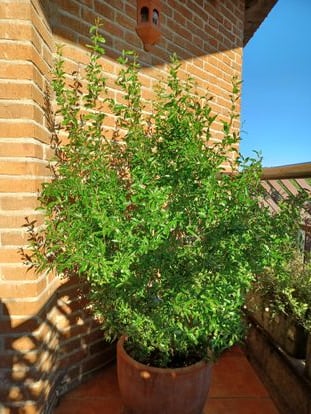A dwarf pomegranate with a fertilization rich in phosphorus and potassium.
The flowering process for a plant is an exhausting moment.
It has to concentrate all its energy on producing organs that, if all goes well, will ensure the individual propagates its genetic load.
To achieve this end, plants make their flowers.
Once fertilized, they will generate the seeds, another prodigy of nature.
In gardening we look hard for that magical moment in which the plants are covered with the colors and aromas of flowers.
When this does not happen, nervousness seizes the person who takes care of them: “Let's see, last year it began to flower in the second week of June.
We are in July, what have I done wrong?
Because, inevitably, we tend to think that we have made some mistake in its cultivation, in a moment of self-incrimination as a gardener.
With something as complex as caring for a living being, there can be several reasons why the plants we raise do not flower properly.
We can cultivate several specimens of a species, but in different varieties.
Well, one of them can be more
exquisite
than the others and not bloom as profusely, or even not at all.
That is what happens to Menchu García, who has two Santa Teresa feathers or orchid cactus ('Epiphyllum var') in his apartment in Madrid: “They are two plants, one next to the other.
While one gives pink flowers every year in November, the other only gave me one flower, orange, four years ago.
It has many leaves, but no flower.
If both have the same type of crop, genetics makes an appearance here, and perhaps it would be good to vary the parameters of the laziest plant, giving it more light, for example.
On many occasions, low lighting is responsible for the lack of flowers.
Simply by changing the location of the plant we enhance this process.
To Antonio García, Galician administrator,
Pilar Cortés's dwarf pomegranate, this week, vigorous but without any flowers.Pilar Cortés
At other times, the absence of flowers may be due to inadequate nutrition.
Yes, plants must also have a balanced diet and have all their needs covered.
Although Pilar Cortés, book editor and avid grower, has a magnificent dwarf pomegranate tree ('Punica granatum' or 'Nana'), it is reluctant to flower as it should.
“This year it put out a single flower, which filled me with joy.
But a few days later it fell off and has not given any more.
I pay it every year in October and February”, but it seems that it is not enough.
We must review that all the parameters are appropriate before issuing a possible verdict that changes our cultivation.
Pilar Cortés lists that "the water is correct, the little tree has many leaves, and it receives direct sunlight for several hours, in the afternoon."
So it seems that the dose of fertilizer must be increased or changed to another that has a greater richness of some of its elements, a very common practice in gardening, so that the plants can conveniently orchestrate their reproductive organs.
Mar Alonso, a plant health specialist who works at Semillas y Plantas Escolares, fervently recommends the application of “organic fertilizers”: “If we want to encourage flowering, we have to get one that is richer in phosphorus and potassium, as both are involved in increased flower production.
Likewise, it is convenient to add some other plant process stimulant to the crop, such as earthworm humus or algae extracts.
They will promote root growth, in addition to providing micronutrients.
In the case of algae,
They also incorporate phytohormones.
Between one and the other, flowering will benefit."
Of course, we have to take into account the water.
There are plants, such as the lilacs ('Syringa vulgaris') or the durillos ('Viburnum tinus') that form their flower buds now, at the beginning of summer.
If they don't have enough water they won't be able to produce them, and they won't bloom the following spring.
On the other hand, other times you have to force the plants to rest, stopping watering them at some point in the year.
This occurs with plants such as certain succulents (cactus and other related ones), or the clivias ('Clivia miniata') and the misnamed amaryllis ('Hippeastrum var'.).
Almost all of them benefit from completely cutting off watering in the winter months and letting the substrate dry for weeks, encouraging subsequent flowering when watered again when temperatures rise.
A poorly applied pruning or more cold or heat than they would like can cause our plants not to bloom.
The essential thing, as always, is to know in depth the species we care for and to document it.
Only then will we be sure to fully enjoy our vegetable companions.










/cloudfront-eu-central-1.images.arcpublishing.com/prisa/KMEYMJKESBAZBE4MRBAM4TGHIQ.jpg)


